Krakow’s Smog Crisis: 4 Steps to Protect Yourself
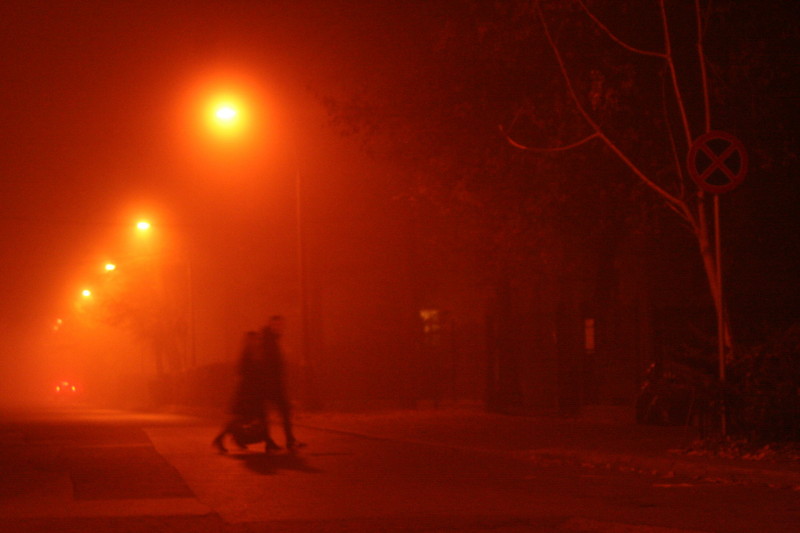
The WHO has ranked air pollution as one of top 10 preventable causes of death. In fact it has predicted that by 2020 there will be 8 million deaths per year due to air pollutants. Yet the air quality in Krakow has devolved to the point where it is often worse than in cities infamous for their smog, like Beijing and Los Angeles.
The air has major health implications for everyone, but especially for vulnerable populations like those with asthma and other chronic diseases. Moreover, the air is especially important for children as they not only play outside but also have developing lungs. As a result of this air, each child in the city is at a higher risk of developing asthma. Particulate pollution, a kind of pollutant made of small particles is especially present in Krakow, has even been found to increase the chance of lung cancer. Apart from the lungs, heart health is directly related to air pollution, as air pollution has been found to contribute to cardiovascular disease and strokes.
According to Jagiellonian University radiologists, a chest x-ray (CXR) of an adult non-smoker who has lived in Krakow their whole lives will show visibly more damaged lungs than the CXR of a patient from a city with cleaner air. The seriousness of the air pollution can no longer be ignored. These problems get worse when it gets cold outside. In the winter, when the pollution from burning coal and wood is unavoidable, already ill patients can have pollution-related exacerbation of their conditions. These exacerbations can result in lengthy hospitalization as physicians work to help patients breathe.
The solutions to the air problems in Krakow involve many political and socioeconomic conditions in the region. Yet while it may take politicians many years before they resolve these problems, residents must act now to protect themselves to minimize the long-term damage. Based on a combination of guidelines from the Center for Disease Control (CDC) and suggestions from Pulmonologists at Jagiellonian University Medical College, the following four steps can help you to act now.
Step 1: Be Informed
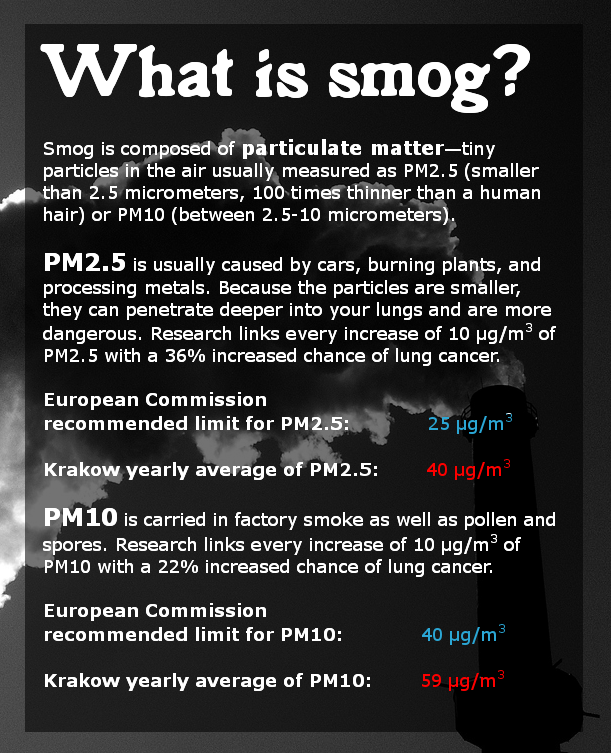
Simply knowing air quality in Krakow is generally poor is not sufficient. Before going outside, physicians recommend patients check the air quality. Go to AQiCN.org (or any comparable site) and check the Air Quality Index (AQI). AQI is a scale between 0-500 that accounts for multiple harmful pollutants and gives a rating for how dangerous the air is for your health.
For example, between 100-150, sensitive adults will feel the effects of the air such as eye irritation and cough. In this range, the CDC recommends children only play outside for short time periods such as a brief recess. Any longer physical activities should include more breaks and parents should avoid allowing their children to participate in more strenuous activities.
Between 150-200 everyone will begin to feel the effects as they breathe and exert themselves. The CDC recommends that strenuous outdoor activities for children should be rescheduled if possible. Unfortunately this range is the norm in much of the summer and winter when there is limited wind. So if possible, schools should mandate that frequent breaks be taken while playing sports.
Above 200, individuals should attempt to stay inside at all times if possible. Being aware of the air quality should be an important step in organizing your day or your children’s activities. So before you leave for work, check the AQI and plan accordingly.
Step 2: Protect Your Home

First, work with your family to prevent any exposure to secondhand smoke. Often neighbors or family members smoke in the hallways or just outside of apartment buildings. But this air still comes into the apartments and harms the vulnerable groups inside. Second, purchase a Carbon Monoxide detector. Leaking chimneys and wood stoves can release dangerous levels of carbon monoxide (CO). CO is not only potentially lethal, but has no odor making it especially dangerous. Third, without effective airtight seals on doors/windows, the poor air from outside still comes inside. So on days with a high AQI, keep the windows closed and use the recirculating air setting on your personal air conditioners if it is warm outside.
The most important myth that must be addressed here deals with air purifiers. In countries like China and India, many have begun purchasing small in-home air purifiers. From a medical and research perspective, however, there is limited proof that any of these small units have any sort of effectiveness, due to many factors. First of all, the range in effectiveness between machines is substantial. Some machines become nothing more than a glorified fan. Moreover, some units have a risk of increasing indoor harmful gases like ozone. Furthermore, without a constant tight seal from the outside air, even a small amount of air let in through a gap in a door or window can undo hours of work of the air purifier. Before considering a filter, work to seal these gaps. For patients with severe asthma or lung diseases, even a minor benefit from these machines could be viewed as beneficial. But most of these machines are not studied, tested, or regulated well enough for the medical community to recommend them. Thus they are not a panacea for indoor pollution protection.
Step 3: Be Smart Outdoors
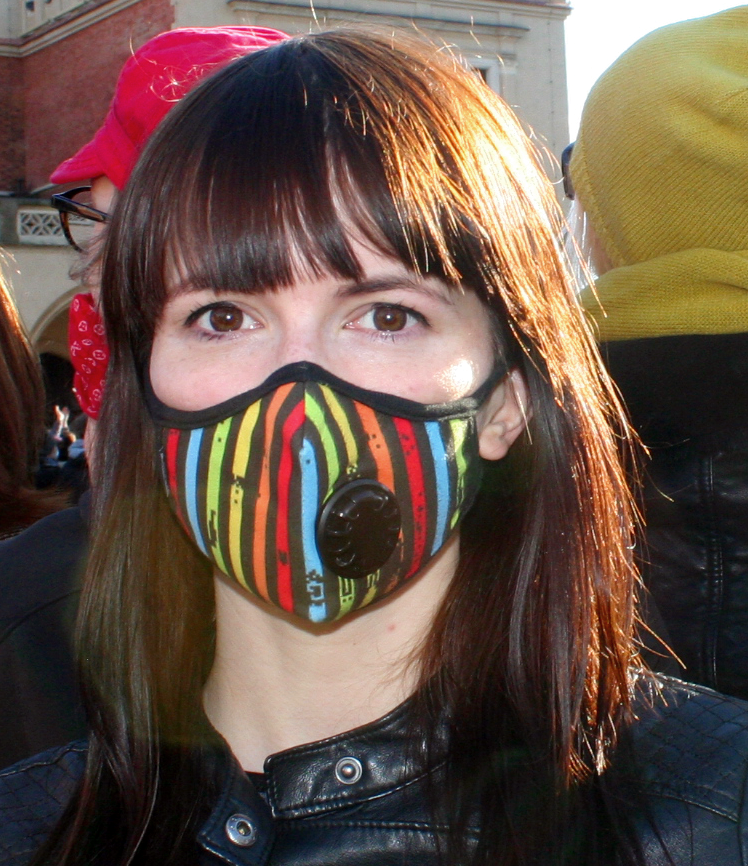 Unfortunately it is unrealistic to only hide inside when the air quality is poor. There are some steps that can be taken to protect the lungs once outside.
Unfortunately it is unrealistic to only hide inside when the air quality is poor. There are some steps that can be taken to protect the lungs once outside.
First of all, do not engage in strenuous activity such as jogging if the AQI is high. Secondly, limit your time outside if possible. The third (and most frustrating step for health professionals) relates to masks. In the Rynek, many residents can be seen walking outside with hospital masks on days with a high AQI. Unfortunately these masks do essentially nothing. They are designed to protect healthcare workers from splashing fluids like blood, not air pollution. Instead, many people go online and purchase more expensive masks they assume will work more effectively. Much like the small indoor air purifying machines, though, most of these masks provide little benefit. Without consistent testing guidelines between countries and producers the effectiveness of each mask varies greatly.
Fortunately, there are some masks that are proven repeatedly in studies to minimize outdoor exposure to fine particulate pollution. These are so-called N95 respirator masks that are usually reserved for high-risk occupational material exposure. They receive their name based on the percent of fine particulates they filter out.
Unfortunately, though, even these masks have many problems associated with them. First of all, these masks usually only protect against particulates, not harmful gasses. So customers still face lung damage by gaseous contaminants in the air. Furthermore, these masks have a limited use since they can only carry a limited amount of particles in their filters. In some circumstances that means that each filter will only be effective for 8 hours before becoming ineffective. So it is important to change as soon as it starts feeling more difficult to breathe. Regarding fit, if a mask does not fit tightly, any small opening between the face and the mask will let polluted air through. So make sure you purchase a mask that has the right fitment. A close fit may not be possible in people with facial hair. Most importantly from a medical point is that these masks can make it difficult to breathe. For patients with COPD and asthma this can lead to life threatening exacerbations. There are some masks with vents on them which make it easier to breathe, but there is still more air pressure than usual. Once the filter is full patients can expect a higher chance of exacerbations of their conditions.
For brief reference, the US Food and Drug Administration (FDA) has approved the 3M Particulate Respirator 8670F/8612F or the Pasture F550G/A520G Respirator. There are other respected brands like Respro and other products, but these are only four examples of studied and proven respirator masks by US guidelines. In short, the effectiveness of these masks is controversial, and in many cases they do nothing at all, so before spending money on any mask found in a store or online, check to see that there is independent testing done to prove its effectiveness.
Filter mask recommendations from Krakowski Alarm Smogowy
(Not affiliated with the author)
| Respro Cinqro | RZMask | Totobobo | Respro BanditScarf | |
|---|---|---|---|---|
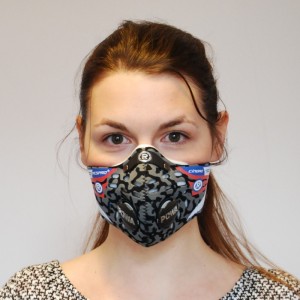 | 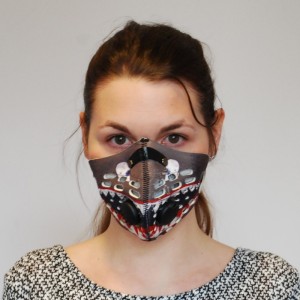 |  |  | |
| Mask price | 279 zł | 125 zł – includes an additional filter and a 10-day guarantee at the shop in Krakow | 90 zł or 100 zł – depending on which model | 119 zł |
| Filter price | URBAN filter, for urban use (HEPA + layer of activated charcoal): 18.99 GBP = about 105 zł for two pieces of filter.SPORTS, without a layer of activated carbon: 14.99 GBP = about 83 zł for two piecesAccording to the manufacturer, filters should be replaced a maximum of 69 hours of use. | 8.50 zł for one or 24 zł for three filters. Manufacturer says that the filter can be used for 20-50 hours, depending on the degree of air pollution. | 10 pairs of filters – 110 zł. Filters should not be used longer than two weeks; must be replaced when the color changes from white to gray (which can be a few hours on bad days in Krakow) | Non-replaceable filter with washable mask. Should be replaced after six months of use. |
| Mask filter type | Both filters retain dust of 0.3 micron, and so much smaller particles than PM2.5 or PM10. The URBAN filter, thanks to the layer of activated carbon, has also stopped compounds such as SO2, NO2, volatile organic compounds and ozone. Because compounds such as NO2 and ozone pollution are typical in traffic, the filter is recommended for people traveling on busy streets. | The filter protects against fine dust (even below 1 micron). It also contains activated carbon, so that should capture gaseous pollutants. For this reason, the filter is recommended for use by people traveling on busy streets. | The manufacturer claims that the filters effectively protect against dust PM2.5 (and dust of 0.3 micron). It does not have an activated carbon filter, therefore, does not protect against the gaseous pollutants: NO2, SO2, ozone, and the like. | The mask-scarf has a built-in active carbon filter, further protected by a special coating, which allows laundering. According to the manufacturer, the mask filters out larger particles (PM10). Therefore, it does not trap smaller particles which are more dangerous for the lungs.. |
| Comfort and appearance | The manufacturer recommends this mask for athletes, because of the special valves that enable easier breathing. We tested a mask while running; in fact the air resistance while inhaling and exhaling is smaller than, for example, the RZ Mask. User feels less that they’re breathing through the mask. With better airflow, the mask does not accumulate moisture so quickly. Sits lower than the RZ Mask, so may be more attractive. Users may notice a “chemical” smell from the materials in the mask. | The mask is very similar to the Respro Cinqro. It has a little more resistance when inhaling and exhaling than the Respro Cinqro. Moisture also accumulates faster than inside the Respro Cinqro. However, both of these factors can make a big difference for athletes. Users may notice a “chemical” smell from the materials in the mask. | Breathe easily, without much resistance, even during sport. Accumulates moisture fairly quickly. It must be quite firmly pressed against the face, so it may leave an imprint when removed. The mask is less soft, particularly around the nose, which can be uncomfortable. The mask does not contain latex, neoprene, or silicone (some people are allergic to these substances). The question is how much the mask can withstand: the manufacturer says that it can be used at least 100 times. It can be very easy to clean—simply remove the filter and wash with soap. Another advantage is the lack of chemical smell. | If positioned at a high level, it may press on the nose and make it difficult to breathe. If it’s too loose, though, it won’t filter the air properly. Not for sport—moisture easily condenses and heavy breathing may be difficult. The product looks more like a scarf pulled over the nose than a mask. Another advantage is the lack of chemical smell. |
| Available sizes | No smaller size than medium, but on average adult M will fit a small face. On the www.respro.com a size table is available. | Two sizes – regular (larger) and medium (smaller). Unfortunately medium proved too large for a woman with a small face. | The mask is a universal size; it can be shaped by immersing it in hot and then cold water. The mask can also be pruned to a smaller size (e.g., For children or adults with smaller faces) and shape. | One size fits all—can also be used for a smaller face (larger children as well) |
| Summary | It’s a good choice for athletes or people who dislike labored breathing through a mask. The only downside is the high price of masks and filters. | Good value for money. Filters with similar characteristics as in the Respro Cinqro. A little less comfortable due to increased breathing resistance compared with the Respro Cinqro. The big advantage is the ability to test the masks. | Distinguished by the possibility of shaping the mask. Lightweight, transparent, and odorless. The downside is the lack of an active carbon filter and fairly quick condensation inside. | The product has the form of a headscarf— great for people who are reluctant to wear a mask. Yet the filter is considered inadequate for Krakow’s air. |
| Link to Product | http://respro.com.pl | http://www.rzmask.pl/ | http://totobobopolska.pl/ | http://respro.com.pl |
(Tomasz Wiech)
Step 4: Do your part

Instead of driving and polluting, take public transport. Half of driving in Krakow involves being stuck in traffic anyways. Next, try not to heat your homes using coal or by simply burning your trash. Coal may be the most cost effective way for staying warm in the winter, but the long term effects the soot has on everyone’s health makes it unacceptable. And finally, educate your friends and colleagues about the importance of protecting themselves from exposure to the polluted air.
The key takeaway is that there have not been enough studies to prove the effectiveness in the long term of these masks or indoor air purifying machines to warrant physicians suggesting them to the general public. Apart from the few lucky enough to have more complex full air circulation filtering, the vast majority of residents will be best off by taking these steps. Stay aware of real-time air conditions, protect your homes and children from the outside air and secondhand smoke, and avoid outside activities when the air quality is poor.
Nitin Gupta is a medical student at Jagiellonian University Medical College and a graduate of the University of Southern California. The above suggestions are a combination of guidelines from the CDC and Pulmonologists at Jagiellonian University Medical College. The author has no affiliation with any of the companies listed in this article and is not a spokesperson for Jagiellonian University. For any medical advice or questions please see your physician.

Thanks for a useful article
be great to have links to places in Krakow where you can buy masks that work and on line shops
Richard
Good idea; that’s been added. : )
It is sad to hear that one of my favorite cities in Europe has become so polluted. I hope not only political leaders but also the community does something to at least partially revert this situation
Thanks for a very useful article. Being fair and open may I say my own Polish family ridiculed this kind of information in Warsaw. Staffers in a local filter shop said many Poels ridicule the above ideas. It is important that a paper publish this kind of article so that more may know about the realities in Krakow and Warsaw and what can be done, some tbhinmgs much more easily. Close to us in the city center others at times within the last two months have burned garbage, cut trees in the garden allotments off of Saska Kepa. Turning a grey area, which should be greener into a more greyer smog. A local hospital got all kinds of people young and old who could not breathe. The aqicn.org site shows help to show others need to open their minds about how bad some cities in Poland have become. Frankly some should send a health damages bill to the Germans and French and others for selling their second hand dirty cars to Poles, as well the newer dirty diesels some called clean cars?.
Hello to everybody!
It remain me a doubt, so there at these masks (at least the ones showed in article) useful to protect from Krakow pollution? or wearing them does not significant difference? I seems to be contradictory information in article
Thank you!
It’s not contradictory. Read the “mask filter type” section.
Thanks for nice summary.
Regarding step 2 protect your home, interesting comments concerning the usefulness of air purifier. Any advises about effective ones?
I have tried to measure air quality at home using air beam.see link below.
https://www.kickstarter.com/projects/741031201/airbeam-share-and-improve-your-air
Not sure about the accuracy but sometimes frightening about the level of pm home… Despite air purifier… As a matter of fact air purifier works under certain conditions, closed room, not a too high pm2.5 level outside. Otherwise cannot keep up with purifying air at an acceptable level.
Measurement through airbeam shows typically values two times higher outside than inside. But when the value outside is 200pm2.5, still 80-100 home . Although everything is closed. (Although apartment ventilation if bad can also bring bad air)
Would be good to know if any similar experiences and what to do?
Professional air purifier ?
Or moving out of Kraków at last -)
Hey there,
thank you for your article!
Could you tell me where I could get an RZ Mask in Kazimierz?
Hi Chris. You can buy them at ECO LOGICAL on ul. Starowiślna 37 (though sometimes they run out when demand is high and you need to wait for a shipment). You can find other purchase locations here on their website.
You
In Europe the standards are not N, R or P. (e.g. N99). They are FFP1, FFP2 (~R95), and FFP3 (~R99). The European FFP standard requires oil resistance, whereas the US NIOSH R and P masks are resistant and proof respectively.
That’s true. During winter air is just terrible. You need to bite it before breath ;)
What do you mean by saying, “…The big advantage is the ability to test the masks…” for RZ mask. How do I test how well it seals on my face if I buy one?
Can you please provide test results showing testing for RZ masks? I have seen online test results for Respro and Totobo but not for RZ. How can you recommend them without test results? eg RZ N2.5 test results of 30 randomly selected people show average filtration of 95% or something like that.